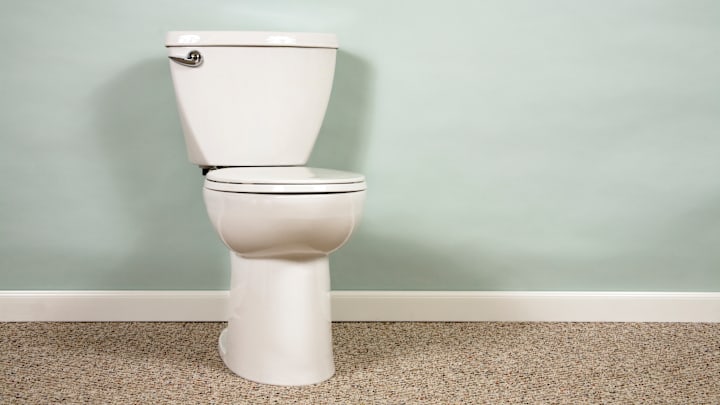Picture a bathmat in its rightful spot: in front of a sink or next to your shower. Now, picture your bathmat carpeting the entire bathroom. The design choice would be unsightly (not to mention unsanitary) to most people in this day and age, but that wasn’t the case for a period from the late 1950s through the 1970s. That raises the question: What motivated homeowners of the past to carpet their bathrooms in the first place?
A Soggy Status Symbol

While everyone’s reasons for carpeting their bathroom might have been different at the time, one motivator was undeniable: Carpet was seen as a symbol of high-class status for much of the 20th century.
For most of human history, carpeting a room with plush fabric wall to wall was a luxury reserved for the ultra-wealthy. Even as carpets became more accessible in the 1950s thanks to technological improvements and the postwar economic boom, the flooring choice maintained its ritzy reputation. New homeowners were eager to cover their bedrooms and living rooms with the once unaffordable amenity. In some cases, they even expanded it to the bathroom so they could enjoy the same affluent feeling from their toilet seats.
You May Also Like:
- This Ingenious Trick Lets You Paint Your Ceiling Without Splatter
- You’re Probably Washing Your Laundry at the Wrong Temperature
- 9 Things You Should Never Clean With Vinegar
Add Mental Floss as a preferred news source!
Carpeted Bathrooms: Endangered But Not Extinct
It’s very uncommon for people to go for a carpeted bathroom nowadays; mold build-up and cleanliness will likely be problems. However, there are a few reasons why someone might still make the bold choice.
Some homeowners may opt for a carpeted bathroom simply because they like the plush feeling under their feet after stepping out of the shower or tub. Others may pick the stylistic choice for its slip resistance. And some might just be in love with the retro style of a carpeted bathroom.
Modern carpeting options may make the choice more appealing to some people. Carpeting that’s 100 percent polyester, for instance, won’t absorb moisture or hold allergens as easily as wool, which was traditionally used. A water-impermeable subfloor would also make it harder for mold to grow beneath the material. Alternatively, carpet squares are easy to remove and clean.
Want to learn more about the history of fuzzy flooring? Here’s why why shag carpets went out of style.
